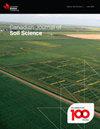Compost and biosolids increase long-term soil organic carbon stocks
IF 1.5
4区 农林科学
Q4 SOIL SCIENCE
引用次数: 0
Abstract
Biobased residues derived from organic urban waste materials can be processed to produce soil amendments that enhance soil fertility and carbon sequestration. However, the extent of carbon sequestration by biobased residues depends on the interaction between their physicochemical properties, climate, and agroecosystem management practices. Our objective was to predict how different biobased residues (compost, anaerobic digestate or biosolids), compared to nitrogen fertilizer, affect soil organic carbon stocks under continuous cropping and crop rotation in Ontario, Canada, using the Century model. The Century model was calibrated and validated with data, from a three-year field study located in Elora, Ontario, Canada, that was used to predict long-term changes in soil organic carbon. Our results showed that after 150 years, soil amended with compost and biosolids increased soil organic carbon stocks significantly (p<0.05) compared to anaerobic digestate and nitrogen fertilizer. Soil organic carbon stocks were 1 to 27% greater with crop rotation compared to continuous cropping. Model performance indicated a strong correlation between measured and simulated soil organic carbon stocks (R2 = 0.26 to 0.82; RMSD = 432 to 727 g m-2). Our findings suggested that compost had the greatest soil carbon sequestration potential of the tested soil amendments, and this difference was due to the quantity and quality of carbon input.堆肥和生物固体增加了长期土壤有机碳储量
从城市有机废物中提取的生物基残留物可以进行处理,生产土壤改良剂,提高土壤肥力和固碳能力。然而,生物基残留物的固碳程度取决于其物理化学性质、气候和农业生态系统管理实践之间的相互作用。我们的目标是使用Century模型预测在加拿大安大略省连作和轮作条件下,与氮肥相比,不同的生物基残留物(堆肥、厌氧消化物或生物固体)如何影响土壤有机碳储量。Century模型是用加拿大安大略省埃洛拉市一项为期三年的实地研究的数据进行校准和验证的,该研究用于预测土壤有机碳的长期变化。我们的研究结果表明,150年后,与厌氧消化物和氮肥相比,用堆肥和生物固体改良的土壤显著增加了土壤有机碳储量(p<0.05)。与连作相比,轮作的土壤有机碳储量增加了1-27%。模型性能表明,测量和模拟的土壤有机碳储量之间存在很强的相关性(R2=0.26至0.82;RMSD=432至727 g/m-2)。我们的研究结果表明,在测试的土壤改良剂中,堆肥具有最大的土壤固碳潜力,这种差异是由于碳输入的数量和质量造成的。
本文章由计算机程序翻译,如有差异,请以英文原文为准。
求助全文
约1分钟内获得全文
求助全文
来源期刊

Canadian Journal of Soil Science
农林科学-土壤科学
CiteScore
2.90
自引率
11.80%
发文量
73
审稿时长
6.0 months
期刊介绍:
The Canadian Journal of Soil Science is an international peer-reviewed journal published in cooperation with the Canadian Society of Soil Science. The journal publishes original research on the use, management, structure and development of soils and draws from the disciplines of soil science, agrometeorology, ecology, agricultural engineering, environmental science, hydrology, forestry, geology, geography and climatology. Research is published in a number of topic sections including: agrometeorology; ecology, biological processes and plant interactions; composition and chemical processes; physical processes and interfaces; genesis, landscape processes and relationships; contamination and environmental stewardship; and management for agricultural, forestry and urban uses.
 求助内容:
求助内容: 应助结果提醒方式:
应助结果提醒方式:


